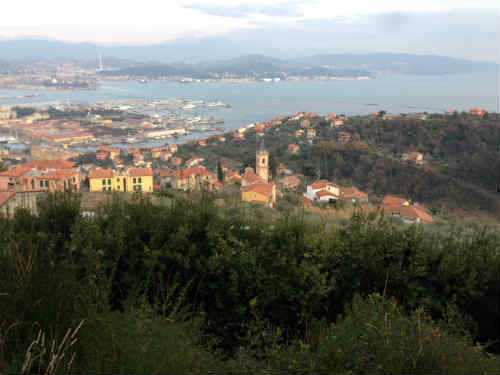LA SPEZIA HILLSIDE VILLAGES
Isola di Felettino
Isola Felettino is mentioned in various documents dating back to between 950 and the 13th century. It is possible that the place name Felettino derives from the name “felce” (meaning fern), or from the word “file”, meaning company, in reference to the group of Byzantine soldiers who were posted on the island. The church of San Vittore and San Michele dates back to before the year 1000, and was originally positioned inside the castle of Isola, which has now completely disappeared. Isola was also once home to a hospice for pilgrims dedicated to San Giacomo Apostolo.
The village still retains its medieval appearance, with paved streets, archways and galleries, as well as the oratorio of San Bernardo, even if the latter owes its current appearance to restoration works completed in the 18th century.
The parish church is now dedicated to Sant’Anna, who was worshipped as far back as the 16th century. The church was opened in 1986. The design of the structure uses simple, clean lines, giving the structure a very modern appearance. The interior consists of one aisle, and is decorated with paintings and wall hangings created by spezian artist Rino Mordaci. The church also houses a statue of Sant’Anna that was recovered from the church of San Bernardo and whose creator remains anonymous. The town of Isola is centred around the church of San Giacomo Apostolo, located on the hills facing Spezia, which give onto an excellent panoramic view of the region. The church houses valuable contemporary paintings, a precious altar and the remains of San Giustino, dating back to the 18th century.
Marinasco
The village of Marinasco jealously guards a historical jewel in the form of the church of Santo Stefano. The village is first mentioned in a document written by the Emperor Arrigo IV in 1077, who describes it as the property of Folco and Ugo Este.
The church, however, is first mentioned in 950 and is the mould in which most of the churches of Spezia were built, with the exception of the church of San Venerio. Although it has been restored many times, the most important changes were made in the 18th century.
Migliarina
The Migliarina area used to hold great importance in the roman era, when there used to be a lot of traffic along the coastal road between Luni and Liguria. Migliarina encompasses the little town of Boron, which was first mentioned in the Tabula Peutingeriana. Boron has links with both the port and the church of San Venerio, the hermit monk who used to live on Tino, who later became the patron saint of Spezia. The church was once positioned in an isolated spot in the countryside surrounding Migliarina, but has since been encompassed by the town of Pieve, near the entrance to Spezia. In 1160 the hospice of San Giovanni Battista was founded and dedicated to the care of pilgrims. The church at Migliarina is also dedicated to San Giovanni Battista. Originally free standing, it was later incorporated into the church of Isola, only to be separated once again in 1633. The islands current church was built in 1926, in the neogothic style, and was opened in 1933. Migliarina is also home to the little church of San Paolo Apostolo, which is located in La Pianta.
Pegazzano
Pegazzano is first mentioned in 1276 as the property of Niccolo Fieschi, who later handed it over to Genova. Remains of ancient Ligurian funerals have been found in the vicinity of Pegazzano, indicating that this has always been a highly populated area.
Pegazzano houses the church of Santo Stefano, which is now closed to the congregations and which was first mentioned in 1470 in a survey taken by the church of Luni.
Pitelli
Pitelli is situated in the hills that surround Spezia, in the direction of Arcola and Lerici. According to tradition, its name comes from “pitti”, which means turkeys in the local dialect. It is also possible that it comes from “piti”, in reference to a group of ancient celtic warriors.
The current naval establishment is built over the ruins of the former centum clavibus hospice, which was completely worn away by the sea. The 18th century church is dedicated to San Bartolomeo Apostolo.
Rebocco
The town of Rebocco is located in the north of Spezia. Rebocco is home to the grotto of the Madonna, which is closed off to the public, and so called thanks to a stalagmite that seems to represent a statue of the Madonna with Child.
The hills of Vivera used to house the ancient church of San Brizio, which was built in the 12th century, but which was destroyed in the course of the military development that has left its mark on almost the entire region. The current church is dedicated to Nostra Signora del Carmine.

Fabiano Alto


